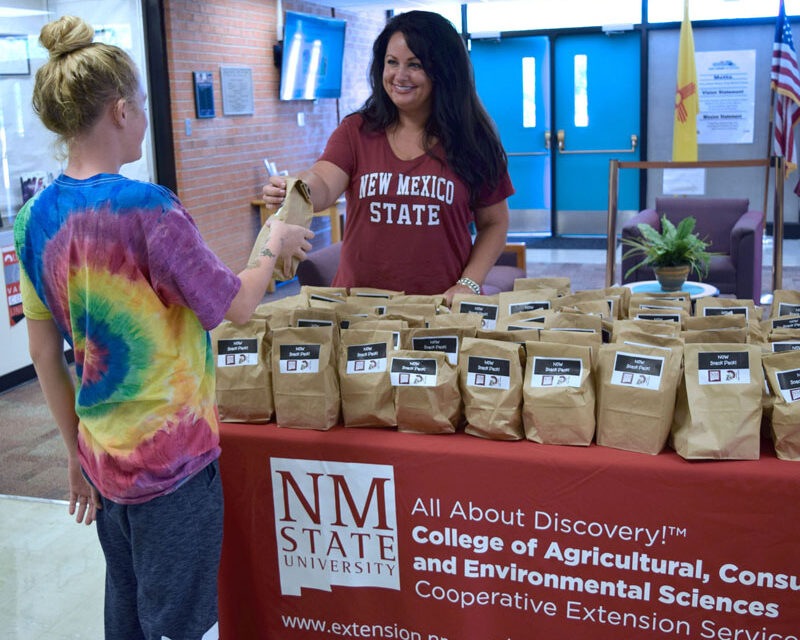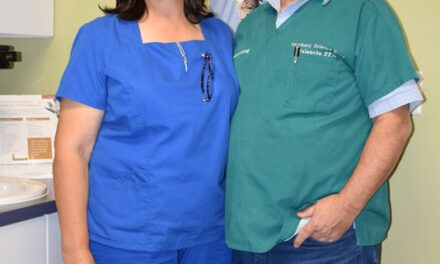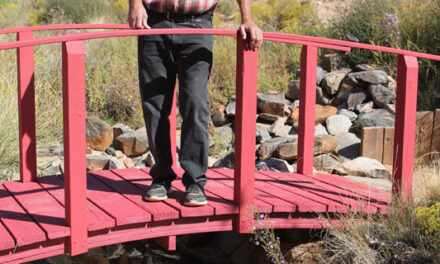LOS LUNAS — New Mexico is ranked 50th in the nation regarding food insecurity with the highest percentage of its residents not having consistent access to enough food for an active, healthy life.
In rural Valencia County food insecurity is a pervasive issue, particularly for the 32 percent of youth under age 18 who live below the poverty level, according to a U.S. Department of Agriculture Economic Research Service 2017 report.
Food insecurity is strongly associated with learning disabilities, decreased productivity, physical and mental health issues, chronic disease and poor family life.
When Laura Bittner, New Mexico State University’s Cooperative Extension Service family and consumer sciences agent in Valencia County, learned that some of the students at Los Lunas Schools’ Century High School experience food insecurity, she knew something had to be done.
“There are many national ‘backpack’ programs for students who do not have food at home, but there are very few national programs addressing this need for high school age students,” Bittner said. “Most of the programs available to high school students are managed on a local or community level. Through ‘backpack’ programs, food is presented to children at the end of the school week, providing something for them to eat during the weekend.”
Bittner, with the support of her county advisory board members, decided it was time to help the 176 students at Century High School, a school designed to give students an opportunity to regain class credits getting them back on track toward graduation.
Since the first week of the 2018-2019 school year, all Century High students are offered a “snack pack” containing non-perishable food requiring no refrigeration or electricity to prepare. Snack packs are distributed on Thursday afternoons, because not all students at Century are required to attend school on Fridays.
The Nutrition on Weekends program has taken on a life of its own. The community has risen to the challenge of donating funds and food, and packing and transporting the snack packs to the school for distribution.
“Since August, over 3,000 snack packs have been distributed,” Bittner said. “We started with $5,000 seed money and as of March 1 we have received $20,000, including $13,933 donated by 91 individuals or organizations from 17 states through the NMSU Foundation ‘Make A Statement’ crowd funding campaign.”
In addition to the “Make A Statement” campaign, local organizations, Los Lunas Rotary Club, four churches and individual community members have donated food and money.
Church members are donating a different type of canned food each week such as peanut butter, peaches or vegetables. They are also packing 500 snack packs each month.
“People really do care. They want to volunteer. They want to help. They want to be part of a solution addressing different issues,” Bittner said. “But people don’t always know how to direct their desire to help. A big part of this program’s success has been educating the community about food insecurity in the state and in their community. I can’t begin to express the incredible, ongoing community support for this outreach effort.”
The impact of the NOW Snack Pack program goes beyond providing food. Students are realizing people they don’t even know care about their success.
“We have conducted surveys with the students and their parents or guardians to learn how they feel about the program,” Bittner said. “When asked in an open-ended question how or if the snack packs have helped them as students, one-fifth of the students wrote the snack packs helped them with their focus, productivity and motivation at school.”
Bittner added that 68 percent of students reported sharing the content of their snack packs with someone at home – a sibling, a grandmother, or a niece, nephew or cousin.
“I recently ran into a student shopping with his father,” Bittner said. “They shared with me that the father has diabetes. The son shares his snacks with his father, leaving them in their vehicle ensuring his father has something to eat when his sugar level drops.”
In another survey, the students were asked how the snack packs made them feel.
“We had a number of students that wrote that it made them happy and they added that they were really grateful that so many people cared about them,” Bittner said.
“This community collaboration is ideally how we want our Extension programs, or our outreach efforts, to work,” Bittner said. “Especially when you look at how great the needs are in some of our communities. The ability to address those needs isn’t accomplished by one person, it requires the community as a whole stepping up to solve or address the issue.”

















